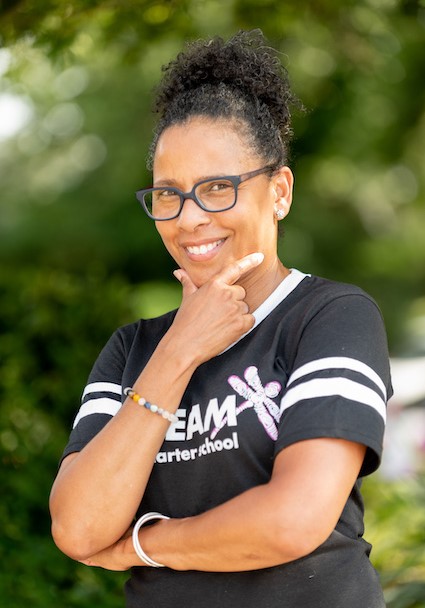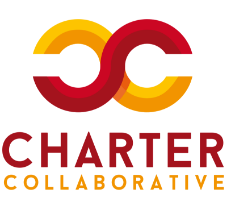
Janine Gomez
Executive Director,
I Dream Public Charter School
I Dream Public Charter School
Location: Washington, DC
Year Opened: August 31, 2020
Student enrollment: 57
Grades served: PreK3-2
Website: www.idreampcs.org
Student Demographics
Asian: 89%
Black/African-American: 98%
Hispanic/ Latino: 8%
Homeless Students: 14%
FRPM/FRPL %: 100%
Students with Disabilities: 14%
ELL/ESL Students: 0%
TWO TRACKS OF EDUCATION
As a child, I was an explorer. I was very curious and always thinking about some big dream to accomplish. I attended a private school in New Haven, CT from 1st-3rd grade. It was a school that allowed me to pursue my dreams, but it was the early 70s, which was very segregated in New Haven. I was the only Black child in my class, and there were only about 4 Black kids in the whole school. When I experienced racism, my parents took me out and I started attending my neighborhood school, where my mother was a kindergarten teacher. Ivy Street School had very limited resources. We didn’t have spines on the books, but the books were what we did. It was all rote learning, skill drilling, and practicing walking in line, so I experienced a school culture shock. In 4th grade, I really understood that there’s an inferior connotation to being Black and there was an inferior school belief about what Black kids needed. I had friends in my neighborhood who were just as into exploring and creating and inventing and building as I was, but the opportunities were different.
I didn’t go to a private school ever again and I lost that love of learning for a long time. I learned how to follow directions, follow a procedure, and get a good grade. My report cards would say, “She has so much potential, but she’s
just not motivated.” In 6th grade, I had an African American teacher, who’s my friend to this day, who infused that joy of learning for that one year. She honored our brilliance.
I went to Georgia Tech and went into Electrical Engineering, because I love designing and building things. I tutored and mentored children along the way, and I would see the gifts that they had and think about how I could grow and
cultivate that. When the power company I worked at in Charlotte, NC downsized in the early 90s, I went back to school and got my Masters in Elementary Education and I never looked back.
After serving as a teacher in Silver Spring, MD and then as a principal in North Carolina, I became principal at Capital City Charter School in Washington, DC. I saw that EL Education is closer to what I’m about, because it’s about guiding learners to doing what they thought was impossible to do, connecting them with learning that matters, and integrating their cultures and perspectives into the learning. But even in that space, there were learners that weren’t thriving. I became a principal coach for EL Education for 4 years and saw the same thing across lots of different schools. There were always low expectations for a certain group of children, children who were undervalued, and it was always along lines of color.
A SCHOOL WHERE BLACK AND BROWN STUDENTS CAN THRIVE
I Dream is a space to reclaim our power, for each child to reclaim their power, and to reclaim community. Community is how indigenous people grow. We build the strength of each person through the strength of the collective. We give you back your right to dream, but dream in community, so you understand your responsibility to the community and yourself.
When our learners get out in the world, they’ll be equipped with the awareness, skills and mindsets they need to be able to navigate this country and this world that have institutionalized, systemic biases and racism. Once you know who you are and why you’re here, that’s something that cannot be taken away from you. If all of our children come out of I Dream with that understanding, they can make choices for their lives. It’s not going to end racism and police brutality, but they will know how to find their purpose and how they’re going to chart their lives. They won’t buy into the inferiority complex that race in America narrates. If we can inspire our children to do that, that’s going to inspire undervalued communities to take their power back and not subscribe to systems that tell them that they’re less than or don’t deserve to be valued or can’t dream. That’s going to inspire cities to think about education differently. And that’s when we change the world.
At I Dream PCS, we develop customized learning plans, inspired by Montessori and EL Education, that involve figuring out where each child is starting and what’s the action plan for each child. Families sit down with our coaches (our teachers are called coaches, because they cultivate your gifts) and their children to create learning plans with individualized academic, social emotional, and dreamer goals based on data. They all agree on what the customized learning goals are (set in early November) and that becomes the document that guides each learner’s work throughout the year. One of the things that sets us apart is that individualized learning also applies to the adults. Our staff each have professional learning plans. We group in professional development based on what skills each adult wants to learn. We highly individualize their learning as well.
Social-emotional learning is an important part of highly customized learning, because emotional intelligence must be developed in order to be able to engage in individualized learning. If a child knows they’re a visual learner, they
can understand how they need to learn best. Understanding if you prefer to work alone and how to collaborate with others are important. Understanding the trauma that learners and staff bring to school and how it impacts people within the community and learning is very important. We have Tribe Time four days a week where learners develop emotional intelligence with a small group, and a Zen Zone for learners to reset when they need it. We’re also working on adults’ trauma and social-emotional learning to ensure they are their healthiest selves with learners and families.
We have been committed since Day 1 to being in Ward 7 or 8. We wanted to bring I Dream to the east side of the Anacostia River, because there aren’t any options like this. Most schools on this side of the river are very traditional. Starting in 2017, we did all of our school engagement here. We built a partnership with the Boys and Girls Club on Mississippi Avenue. We had to develop trust with the community and our families.
COVID-19 SILVER LININGS
This is actually the perfect time to start our school, because everyone is thinking outside the traditional box of what school should be. We came in with “We’re not doing the traditional box,” and now we’re seeing that people are understanding that one size doesn’t fit all. We were already focused on individualizing learning and co-creating with families and communities, and now everyone is realizing that you have to do that, because everyone is experiencing the pandemic differently. The blanket approach was easier for traditional schools, but it doesn’t work in this pandemic.
We had to figure out remote learning, because our model is really about building relationships, collaborating, having children engage in their interests and passions. With our culture of looking at who each child is, who each family is, what their needs are and what their brilliance and values are, we’ve created a schedule where children are coming together in the morning and we’re building in movement breaks and other activities as needed. We ask families to tell us when independent learning can happen. The components of our schedule are put together differently based on what the family and the learner needs.
As a new charter school, we would have had a lot more monitoring, but now it’s more about how are you engaging families and meeting their needs and including their voice in this plan that you’re building. Our virtual classrooms are so joyful and creative. Our coaches are coming up with amazing lessons, connecting to learners and building in science, art, dance, and music.
WALKING THE TALK
I founded a school knowing the historical trend of schools led by people of color being targeted and shut down more often. Being an African American woman school founder, I know that people are watching and judging how I lead, and the quality of the school that I lead. Even through the experience of the charter application, there was definitely a bias around what an African American woman founder can do or can’t do. I saw that in the process, and I voiced it often with people who offered support. Everyone involved in authorizing and supporting new schools need to do their own work around bias, prejudice, and racism.
I’m going to make sure our program is on point. I Dream PCS school leaders and staff began the school year with a clear understanding of our vision and mission. Together, we’re going to make sure we’re doing what we said we are going to do, because there are too many schools that don’t do what they promised communities east of the Anacostia River they would do. I need to be on top of I Dream’s finances, because that’s how a lot of schools get shut down. Along with test scores and compliance with local and federal regulations. Learning is most important at I Dream, but I know, as Executive Director, I must also focus on what is required to be successful in the charter school game.
